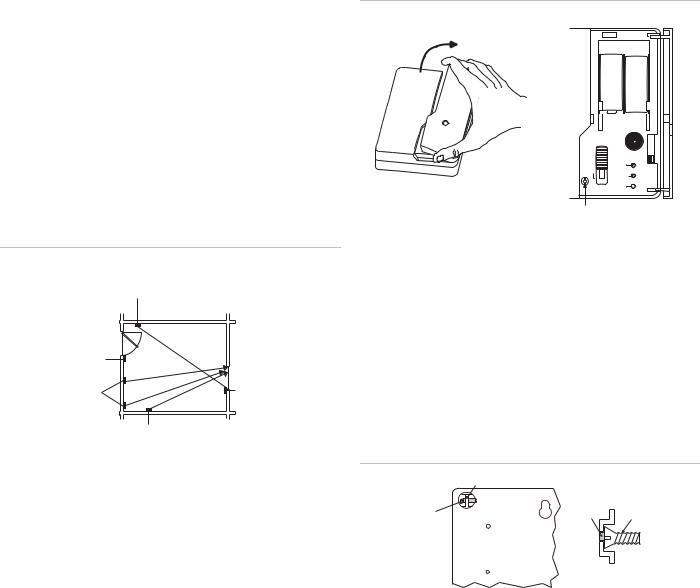GE Security 60-834-95 Installation

Adjustable Dual Technology Sound Sensor
Installation Instructions
Product summary
The sensor (60-834-95, 60-765-43) is a dual technology glassbreak detector that uses a single microphone for detecting both flex and audio frequencies. Since glass breaking must be both detected and verified, false alarms are virtually eliminated.
The sensor detects glass breakage of windows within 25 feet.
How It Works
The microphone is sensitive to different frequencies. It detects both the ultra-low frequencies produced by a blow to a glass window and the higher frequencies produced by breaking glass.
The audio technology remains inactive until the microphone detects a blow to the glass. Once this happens the microphone must also detect the frequency of breaking glass, within a defined time-window after the flex circuitry detects a blow to the glass. Only then does the sensor go into alarm.
The sensor is powered by two 3.6V Lithium AA batteries (included).
The sensor can be used with the glass types and thicknesses shown in Table 1 below.
Table 1: Glass types and thicknesses
Glass type |
Thickness (inches) |
|
|
Plate |
3/32 |
|
|
Tempered |
1/8 |
|
|
Laminated |
1/8 |
|
|
Wired |
1/4 |
|
|
For the sensor to work properly, the glass size must be at least 10-7/8” x 10-7/8”.
Tools Needed
•Small Phillips Screwdriver
•Small Flathead Screwdriver
•Screws and Anchors (included)
•Small Needle-Nose Pliers
•M4 or M5 Screw
•Sound Sensor Tester (part number 13-332)
Programming
The following steps describe the general guidelines for programming (learning) the sensor into panel memory. Refer to the specific panel installation instructions or reference manual for complete programming details.
1.Set the panel to the program mode.
2.Proceed to the LEARN SENSORS menu.
3.Select the appropriate sensor group and sensor number assignments.
4.When prompted by the panel to trip the sensor, activate the sensor tamper by opening the sensor door.
5.Exit program mode.
P/N 466-1726 • REV E • 16FEB11 |
1 |

Installation
Guidelines
Determine the best mounting location for the sensor using the following guidelines:
•Mount the sensor on the ceiling or on a wall at least 7 feet from the floor with a direct and unobstructed line-of-sight of the protected glass.
•Mount the sensor within 25 feet of the glass to be protected (see Figure 1 below).
Figure 1: Sensor mounting locations
|
POOR LOCATION |
|
|
|
|
|
|
|
|
|
FULLY OPENED DOOR CAN |
|
|
|
|
|
|
||
|
BLOCK SENSORS VIEW |
|
|
|
|
|
|
|
|
POOR LOCATION, |
|
|
|
|
|
|
|
|
|
HIGH RISK OF |
|
|
|
|
|
|
|
|
|
DOOR SLAM |
|
|
XIMUM |
|
|
||||
|
25' MA |
|
|
||||||
|
|
|
|
|
|
|
|
||
|
|
|
|
|
|
M |
|
|
|
|
|
|
|
|
U |
|
SATISFACTOR |
Y |
|
OPTIMUM |
|
|
IM |
|
M |
||||
|
AX |
|
|
|
|
|
|||
|
|
'M |
|
|
|
U |
|
|
|
|
5 |
|
|
|
M |
|
LOCATION |
|
|
LOCATIONS |
2 |
|
|
XI |
|
|
|
||
|
|
A |
|
|
|
|
|
||
|
|
'M |
|
|
|
|
|
|
|
|
|
25 |
|
|
|
|
|
|
|
|
SATISFACTORY |
|
|
|
|
|
|||
|
LOCATION |
|
|
|
|
|
|
|
|
Note: Curtains, blinds, and other window coverings can absorb energy from breaking glass. For example, heavy curtains will effectively block the sound signal. In these cases, mount the sensor behind the window covering next to or above the window.
•Do not mount the sensor next to air ducts, forced air fans, or bells measuring 2 inches (or larger) in diameter
•Do not mount the sensor near doors and windows that can be slammed (see Figure 1 above).
•Do not mount the sensor where furniture may be placed between the glass and the sensor.
•Do not mount the sensor on posts, free-standing or otherwise.
•Do not mount the sensor where a door can be closed between the sensor and the glass or where an open door may obstruct sensor line-of-sight (see Figure 1 above).
Figure 2: Opening cover to locate and remove cover screw
|
- |
+ |
|
|
|
3.6V |
3.6V |
|
|
|
LITHIUM |
LITHIUM |
|
|
|
AA |
AA |
|
|
|
BATTERY |
BATTERY |
|
|
|
|
|
|
TEST MODE |
ENABLED |
AUDIO |
ON OFF |
2 |
1 |
LED |
ALARM |
|
ENS |
ENS |
|
|
S |
S |
|
|
FLEX |
|
|
|
SCREW
2.Remove the sensor cover by first pulling up at the top of the cover then lift up at the bottom. Set the sensor cover aside.
Note: Steps 3 and 4 provide instructions on how to enable the wall tamper switch. For commercial UL listed systems the wall tamper switch must be used. If not using the tamper switch feature, move on to step 5.
3.Enable the wall tamper switch by removing the plastic tab on the back of the sensor using the needle-nose pliers (see Figure 3 below).
Figure 3: Wall tamper switch
Plastic Tab
Wall |
|
|
Tamper |
Wall |
|
Arm |
Tamper |
Scre w |
|
Arm |
|
|
(Side View) |
|
(Back of Sensor |
) |
|
4. Screw the M4 or M5 screw into the wall or ceiling so that it will make contact with the wall tamper arm.
5. Place the sensor base at the desired location on the wall or ceiling (over tamper screw if installed) and mark the narrow portion of the mounting holes (see Figure 4 on page 3)
Mounting the Sensor
Mount the sensor using the following procedure:
1.Open the sensor door and remove the cover screw using a Phillips screwdriver (see Figure 2 below).
2 |
Adjustable Dual Technology Sound Sensor Installation Instructions |
